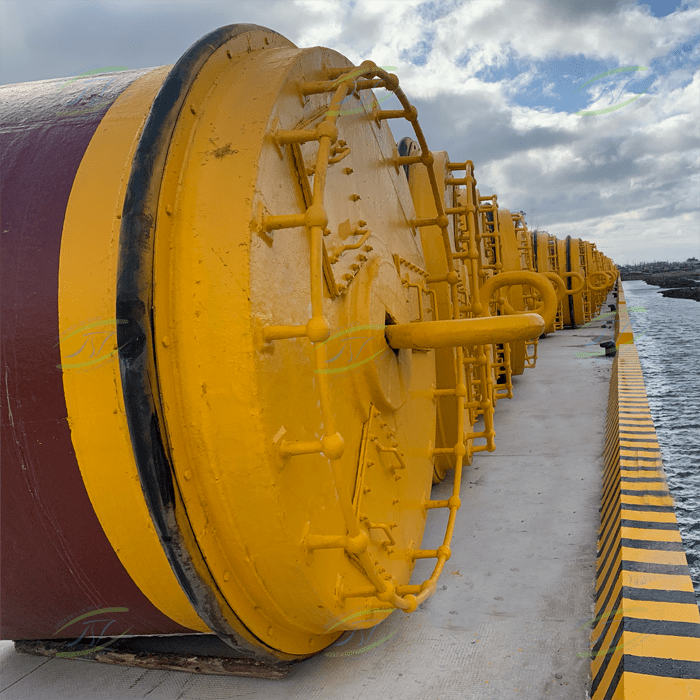Mooring Buoy
1. Mooring Buoy Overview
A Mooring Buoy is a floating device designed to provide a fixed mooring point for ships and boats without dropping an anchor directly to the seabed, lake, or river.
This system plays a vital role in the maritime industry by minimizing environmental impacts on the seabed, improving port operation efficiency, and ensuring safe mooring.
2. Structure and Working Principle
Mooring Buoys consist of specialized mechanical and structural components, engineered to withstand heavy loads and harsh marine environments.
2.1. Buoy Body
- Materials: High-strength steel, HDPE plastic, composite fiber, or corrosion-resistant polyurethane.
- Shapes: Spherical, cylindrical, or oval, depending on design load and conditions.
- Protective Coating: Epoxy anti-corrosion paint or anti-fouling coating to extend service life.
2.2. Mooring System
- Mooring Eye: The main connection point between the Mooring Buoy and vessel, reinforced with stainless steel or corrosion-resistant alloy.
- Mooring Chain: Heavy-duty chain connecting the buoy to the anchor block on the seabed, keeping the buoy stable in position.
- Anchoring System: Gravity anchor, embedded anchor, or suction anchor, depending on seabed geology.
2.3. Identification System
- Signal Paint: Mooring Buoys are painted yellow following international conventions for visibility.
- Navigation Light: Some buoys are equipped with IALA-compliant flashing lights for night or poor weather conditions.
- Monitoring Sensors: Advanced buoys can integrate GPS, load sensors, or AIS communication for remote management.
3. Applications of Mooring Buoys in Maritime Industry
3.1. Vessel Mooring Support
Mooring Buoys are widely used in:
- Seaports: Supporting cargo ships, container vessels, and oil tankers while waiting for berth.
- Resort Areas: Yachts and cruise ships moor safely without dropping anchors onto coral reefs.
- Deep Sea Areas: Ideal for locations unsuitable for traditional anchoring.
3.2. Marine Environmental Protection
The use of Mooring Buoys reduces anchor damage to seabeds, especially in coral reef or sensitive ecosystems.
3.3. Offshore Oil & Gas Operations
Mooring Buoys are essential for stabilizing FPSOs, mobile drilling rigs, and other offshore facilities.
4. Advantages of Mooring Buoys vs. Traditional Anchoring
| Criteria | Mooring Buoy | Traditional Anchoring |
|---|---|---|
| Ship Stability | Stable, less drifting | Depends on seabed conditions |
| Environmental Impact | Minimal seabed damage | May harm marine ecosystems |
| Mooring Time | Quick and convenient | Time-consuming |
| Maintenance & Cost | Low maintenance, long lifespan | Frequent anchor checks & replacements |
5. Conclusion
Mooring Buoys provide an optimal solution in the maritime industry, ensuring safety, reducing environmental impact, and improving operational efficiency.
With modern technologies such as GPS monitoring, load sensors, and automatic mooring systems, Mooring Buoys will continue to enhance offshore and port operations in the future.
Mooring Bollard Accessories
Mooring Bollards are easy to install during port construction. Anchor bolts can be embedded in concrete or installed later with chemical anchors or Sika.
Positioning is supported by jigs/templates for accuracy and compliance with port safety standards.
Installation is carried out using cranes, tugboats, and basic construction tools.
Projects Completed
- Hyosung Chemical Port (2019–2021)
- Cai Mep General Port
- Lotus Port
- Ca Na Port
- Petrolimex Port
- Cai Lan Port
- K662 Military Fuel Depot
- Military Port Renovation – 7th Military Region
- Bac Van Phong Port
- Xuan Thanh Cement Plant – Khanh Hoa
- Song Hau 1 Thermal Power Plant – Package BS04
- Pier A3 & A3 Extension – Go Dau Port, Dong Nai
- Xuan Thanh Cement Plant – Cam Ranh
- Thang Long Cement Plant – Quang Ninh
- Go Dau B Port – Dong Nai
- Chu Lai – Truong Hai Port
Other Fender Products
- Lambda Fender
- SPC Fender
- Cylindrical Fender
- PPI Fender
- Mooring Bollards
- Rubber Ladders
- Marine Accessories
